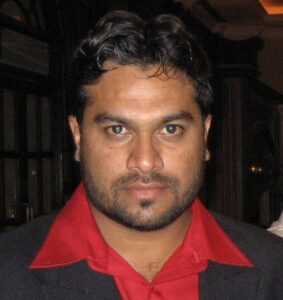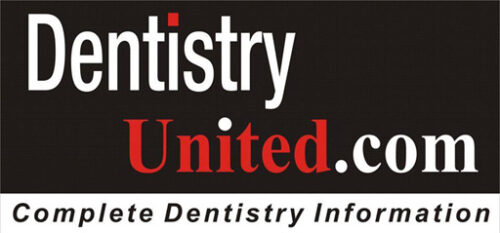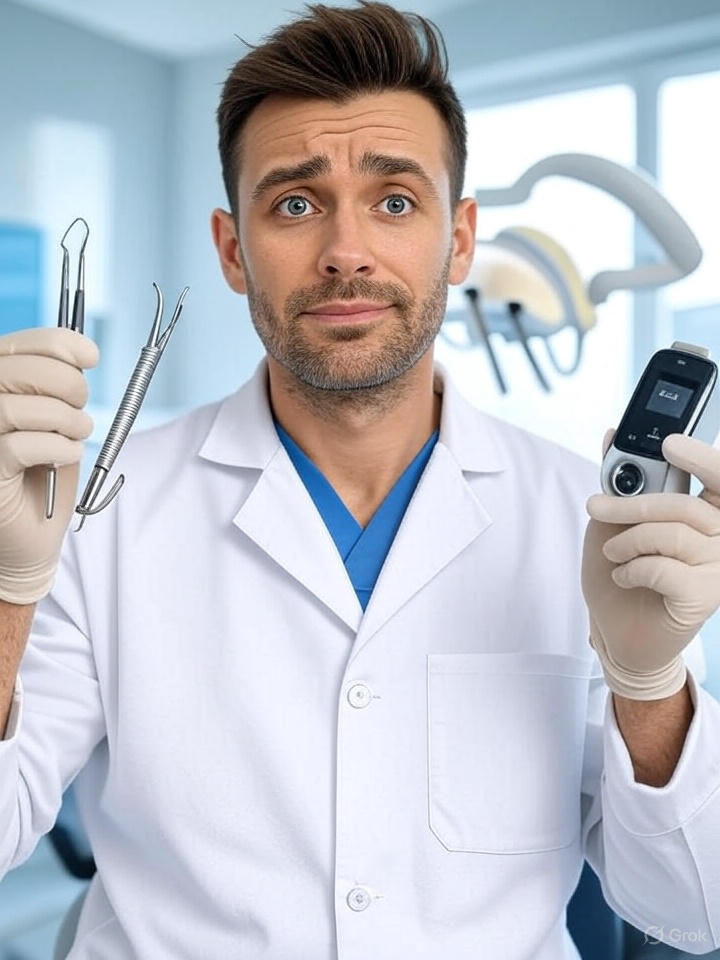By Dr. Syed Nabeel, BDS, D.Orth, MFD RCS (Ireland), MFDS RCPS (Glasgow)

This morning, as the first light of Mysore filtered through my window, I sipped a steaming cup of sulaimani chai and opened X on my tablet. Among the usual flurry of dental debates and clinical queries, a post from a colleague in dental informatics arrested my attention: Microsoft’s 2025 study, AI vs Jobs: Microsoft Reveals the 40 Most Affected and 40 Still Safe in 2025. Drawing on 200,000 interactions with Microsoft Copilot, the study maps AI’s transformative potential across professions. As I delved into its findings, I found myself reflecting on my own writings—penned over months of grappling with AI’s promise and perils in dentistry (Nabeel, 2025a; Nabeel, 2025b; Nabeel, 2025c). The study’s data crystallized a conviction I’ve long held: AI is a powerful ally, but in the intricate dance of clinical dentistry, the human hand and mind remain the lead. Through a detailed implant dentistry case, this essay explores why specialties like oral and maxillofacial surgery and prosthodontics resist automation, how AI can amplify our craft, and why clinicians must wield both scalpel and algorithm with equal finesse.
The Resilience of Clinical Craftsmanship
The Microsoft study introduces “AI Applicability Scores,” a triad of metrics—coverage (frequency of AI assistance), completion (success in task execution), and scope (breadth of job responsibilities covered)—to gauge AI’s impact on occupations. Oral and Maxillofacial Surgeons (score: 0.03) and Prosthodontists (score: 0.10) rank among the least affected, nestled in the study’s “bottom 40” (Microsoft Research, 2025). This aligns seamlessly with my arguments in Why Dentists Must Adopt AI Cautiously: dentistry’s core—tactile precision, patient-specific judgment, and biological nuance—defies algorithmic capture (Nabeel, 2025a).
Consider the surgical theater: an osteotomy demands real-time adaptation to anatomical variations, such as an unforeseen sinus floor irregularity. Prosthodontics, too, hinges on sensory finesse—adjusting a restoration’s occlusal harmony to suit a patient’s unique biomechanics. The Microsoft study underscores that tasks requiring physical presence, manual dexterity, and contextual improvisation remain AI’s blind spots, as its strengths lie in data processing, not embodied expertise (Microsoft Research, 2025). Yet, as I’ve argued in Artificial Intelligence in Dentistry: The Present Pulse and the Path Ahead, AI’s supportive role—enhancing diagnostics, streamlining workflows—holds immense potential when guided by a clinician’s wisdom (Nabeel, 2025b).
A Case Study: Human Expertise in Implant Dentistry
To illustrate, let us examine a recent case from my practice at Smile Maker Dental Clinics, Mysore, INDIA, which exemplifies the synergy—and limits—of AI in implantology. A general dentist, expanding his implant practice, sought a consultant for a challenging full-arch rehabilitation with immediate loading. The patient, a 52-year-old with a history of bruxism and partial edentulism, required a solution balancing aesthetics, function, and longevity. The dentist received numerous applications, many showcasing AI-generated treatment plans—polished outputs from tools like 3Shape Automate or CephX, promising optimized implant trajectories and crown designs. Yet, he selected a clinician whose approach married digital precision with clinical intuition.
Employing Cone Beam Computed Tomography (CBCT), the consultant meticulously analyzed cross-sectional views to assess bone volume and trabecular density, complemented by intraoral scanning for precise cortical anchorage mapping. AI tools proved invaluable here: they flagged a subtle radiolucency suggestive of early bone resorption and suggested implant angulations to maximize primary stability. The software generated a digital wax-up, simulating occlusal contacts and aesthetic outcomes for patient consultation. However, the procedure’s success hinged on human expertise. During surgery, the consultant encountered an unexpected thinning of the buccal plate, requiring a modified flap design to preserve soft tissue integrity. Tactile feedback guided the osteotomy, ensuring precise torque values (35 Ncm) for implant stability. Post-placement, she adjusted the provisional restoration’s occlusal scheme to mitigate the patient’s bruxism, a nuance AI could not intuit without explicit programming.
This case echoes the Microsoft study’s findings: AI excels in data-heavy tasks like radiographic analysis (with completion rates up to 85% for diagnostic tools) but falters in dynamic, hands-on interventions (Microsoft Research, 2025). As I noted in A Reflection on Microsoft’s MAI-DxO, AI can orchestrate data streams—cross-referencing CBCT with patient histories—but the clinician’s hand and eye translate these into reality (Nabeel, 2025c). The consultant’s ability to adapt to intraoperative surprises and tailor the restoration to the patient’s neuromuscular profile underscores why AI remains a tool, not a replacement.
AI as an Ally: Enhancing, Not Eclipsing
While AI cannot wield a scalpel or sense a patient’s unspoken anxiety, its role in peripheral workflows is transformative. In AI in Healthcare: From Hype to Helper, I explored how AI streamlines repetitive tasks, freeing clinicians to focus on what matters most: the patient (Nabeel, 2025d). The Microsoft study highlights AI’s prowess in information processing and communication, which translates to dentistry as:
- Radiographic Analysis: Tools like dentalXrai Pro detect caries or periapical pathology with 89% accuracy, accelerating diagnosis (Nabeel, 2025b).
- Digital Planning: AI-driven platforms like DentalMonitoring’s ScanBox enable remote monitoring, enhancing orthodontic follow-ups (Nabeel, 2025b).
- Administrative Efficiency: Speech-to-text tools, such as Copilot, draft progress notes or consent forms, reducing clerical burden (Microsoft Research, 2025).
- Aesthetic Visualization: Smile design software simulates outcomes, aiding patient communication (Nabeel, 2025e).
Yet, as I cautioned in Risks of Over-Relying on AI, over-dependence risks “cognitive debt”—a erosion of clinical intuition, as evidenced by studies showing diminished neural connectivity when outsourcing reasoning to AI (Nabeel, 2025f; Kosmyna et al., 2025). The Microsoft study reinforces this: AI’s task completion is imperfect, and its scope in complex decision-making is limited (Microsoft Research, 2025). A humorous anecdote from Rain, AI & Fritters comes to mind: a patient, armed with an AI app’s diagnosis of “ten root canals,” nearly underwent unnecessary treatment until Dr. Pavan’s expertise intervened (Nabeel, 2025g). Such cases remind us that AI’s outputs demand human scrutiny.
The Clinician’s Charge: Mastery in a Digital Era
In Agentic Artificial Intelligence in Healthcare, I argued that AI should be a partner, amplifying our capacity for precision and empathy (Nabeel, 2025h). The Microsoft study’s low AI applicability for surgical and prosthetic dentistry affirms this: our tactile mastery and biological insight are the bedrock of our craft. To thrive, clinicians must embrace a dual fluency:
- Hone Clinical Acumen: Perfect your flap elevation or occlusal adjustment—skills AI cannot replicate.
- Leverage AI Tools: Adopt platforms like Pearl’s Second Opinion for diagnostics or 3Shape for CAD/CAM, as outlined in How Can Dentists Be AI/ML Ready? (Nabeel, 2025i).
- Uphold Ethics: Ensure AI respects patient privacy and equity, as emphasized in Synthetic Data, Real Judgment (Nabeel, 2025j).
- Commit to Learning: Engage with DentistryUnited’s webinars or ADA-accredited courses to stay AI-fluent, as recommended in AI’s Impact on Dental Specialties (Nabeel, 2025k).
As Abraham Lincoln reputedly said, “Give me six hours to chop down a tree, and I will spend the first four sharpening the axe.” In dentistry, our clinical expertise is the blade, honed by years of practice. AI is the handle, enhancing efficiency without supplanting skill. The clinician who masters both—wielding scalpel and algorithm with equal precision—will shape the future of oral healthcare.
References :
- Kosmyna, N., et al. (2025). Your Brain on ChatGPT: Accumulation of Cognitive Debt when Using an AI Assistant for Essay Writing Task. arXiv:2506.08872
- Microsoft Research. (2025). AI vs Jobs: Microsoft Reveals the 40 Most Affected and 40 Still Safe in 2025. Available at: https://guidlix.com/microsoft-study-top-40-ai-affected-jobs [Accessed 31 Jul. 2025].
- Nabeel, S. (2025a). Why Dentists Must Adopt AI Cautiously: A Case Against Over-Automation in Restorative and Orthodontic Practice. Available at: https://www.dentistryunited.com/why-dentists-must-adopt-ai-cautiously-a-case-against-over-automation-in-restorative-and-orthodontic-practice/ [Accessed 31 Jul. 2025].
- Nabeel, S. (2025b). Artificial Intelligence in Dentistry: The Present Pulse and the Path Ahead. Available at: https://www.dentistryunited.com/artificial-intelligence-in-dentistry-the-present-pulse-and-the-path-ahead/ [Accessed 31 Jul. 2025].
- Nabeel, S. (2025c). A Reflection on Microsoft’s MAI-DxO and the Future of AI in Dentistry and Medicine. Available at: https://www.dentistryunited.com/a-reflection-on-microsofts-mai-dxo-and-the-future-of-ai-in-dentistry-and-medicine/ [Accessed 31 Jul. 2025].
- Nabeel, S. (2025d). AI in Healthcare: From Hype to Helper – A Perspective for Doctors and Dentists. Available at: https://www.dentistryunited.com/ai-in-healthcare-from-hype-to-helper-a-perspective-for-doctors-and-dentists/ [Accessed 31 Jul. 2025].
- Nabeel, S. (2025e). AI in Dentistry: Revolutionizing Facial Aesthetics Through Advanced Treatment Planning, Execution, and Post-Operative Analysis. Available at: https://www.dentistryunited.com/ai-in-dentistry-revolutionizing-facial-aesthetics-through-advanced-treatment-planning-execution-and-post-operative-analysis/ [Accessed 31 Jul. 2025].
- Nabeel, S. (2025f). Risks of Over-Relying on AI for Doctors and Students. Available at: https://www.dentistryunited.com/risks-of-over-relying-on-ai-for-doctors-and-students/ [Accessed 31 Jul. 2025].
- Nabeel, S. (2025g). Rain, AI & Fritters: A Dental Drama With No Patients (But Plenty of Snacks). Available at: https://www.dentistryunited.com/rain-ai-bajji-a-dental-drama-with-no-patients-but-plenty-of-snacks/ [Accessed 31 Jul. 2025].
- Nabeel, S. (2025h). Agentic Artificial Intelligence in Healthcare: Principles, Applications, and Ethical Considerations. Available at: https://www.dentistryunited.com/agentic-artificial-intelligence-in-healthcare-principles-applications-and-ethical-considerations/ [Accessed 31 Jul. 2025].
- Nabeel, S. (2025i). How Can Dentists Be AI/ML Ready? A New Dentist’s Journey into AI and Machine Learning: Dr. Karen Popescu’s Path Forward. Available at: https://www.dentistryunited.com/how-can-dentists-be-ai-ml-ready-a-new-dentists-journey-into-ai-and-machine-learning-dr-karen-popescus-path-forward/ [Accessed 31 Jul. 2025].
- Nabeel, S. (2025j). Synthetic Data, Real Judgment: How Medical Professionals Anchor AI’s Future. Available at: https://www.dentistryunited.com/synthetic-data-real-judgment-how-medical-professionals-anchor-ais-future/ [Accessed 31 Jul. 2025].
- Nabeel, S. (2025k). AI’s Impact on Dental Specialties: From Least to Most Affected. Available at: https://www.dentistryunited.com/ais-impact-on-dental-specialties-from-least-to-most-affected/ [Accessed 31 Jul. 2025].
About the Author
Dr. Syed Nabeel, BDS, D.Orth, MFD RCS (Ireland), MFDS RCPS (Glasgow), is a clinician-scholar whose career spans over two decades at the intersection of orthodontics, neuromuscular dentistry, and digitally integrated diagnostics. As Clinical Director of Smile Maker Clinics Pvt. Ltd., he has pioneered a philosophy of care rooted in anatomical precision, occlusal neurophysiology, and contemporary AI-enhanced workflows. A Diplomate in Orthodontics from Italy and an alumnus of advanced programs at Various International Universiteis , Dr. Nabeel brings a globally benchmarked clinical acumen to the nuanced management of temporomandibular disorders, esthetic rehabilitation, and algorithm-guided orthodontics.
In 2004, he founded DentistryUnited.com, a visionary platform connecting over 40,000 dental professionals through peer learning and collaborative dialogue. His academic drive led to the launch of Dental Follicle – The E-Journal of Dentistry (ISSN 2230-9489), a peer-reviewed initiative now indexed in EBSCO, fostering interdisciplinary scholarship across clinical domains.
A prolific educator, he has contributed to UGC and national broadcast media as a subject expert and regularly speaks at scientific forums, favoring small-group, discussion-based formats that emphasize clinical realism over theoretical abstraction. His ethos remains steadfast: knowledge, when shared freely, multiplies in value. Dr. Nabeel continues to shape the future of dentistry through research, mentorship, and his enduring commitment to elevating practice standards in India and beyond.

